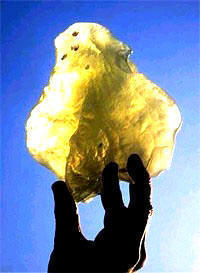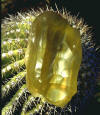|
from
Science Frontiers
ONLINE
Website
Uninhabited, windblown and foreboding, the Sand Sea, near the Gilf Kebir Plateau, was nonetheless the site of a remarkable discovery in 1932.
The Egyptian Desert Surveys under the able direction of Englishman Patrick
A. Clayton (1896-1962) recovered specimens (about 50 kg) of an unusual,
often beautiful, translucent to transparent, yellowish-green gem-like, high
silica natural glass.
This latter exploration involved three scientists stopping over for only two hours and collecting some 24 samples of the glass. During this brief visit, the expedition accidentally found the site of a forced landing of an Egyptian aircraft with the remains of nine men.
The failure of Egyptian authorities
to find the downed airplane for over three years is solemn validation of the
remoteness of this arid region.
In 1900, Professor Franz E. Suess of Vienna coined the term tektite from the Greek tektos meaning "melted or molten." Tektites are compositionally restricted, high silica, natural glasses distinguishably different from other, volcanically derived, natural glasses.
Tektites range in size from microscopic (less than 1mm) to macroscopic weighing many kilograms. They exhibit a marvelous range of colors from water clear, gem quality, deep forest greens of moldavites to the soothing pale to dark yellow and yellow-greens of Libyan Desert Glass as well as the stygian, impenetrable black of Australites.
Isotopic data shows there are at least six recognized geographical distributions (strewnfields) of tektites on Earth. In addition, a few other concentrations of natural glasses are being studied for possible inclusion as bona fide tektites. The study of microtektites, in particular, has dramatically expanded the size of some of the known strewnfields.
Tektites are often confused with obsidian. While both are natural glasses, the volcanic origin of obsidians has been undeniably established.
The origin of tektites, on the other hand, is not well understood and the conflict of theories remains puzzling and unresolved.
In many ways, the large chunks of
natural glasses such as Libyan Desert Glass and Muong Nong tektites are even
more puzzling than the more traditionally recognized aerodynamic tektite
forms.
In a historical context, the earliest theories surmised an artificial provenance. (i.e. manmade glasses). Charles Darwin made the first scientific study of tektites (Australites) during his famous five year voyage on HMS Beagle. He deduced a volcanic origin. Fortunately his theory of evolution was more astute than his belief that tektites were volcanic bombs! His opinion on tektite origins, however, held sway until the beginning of the 20th century.
Since
then, a multitude of other theories, including several extraterrestrial
origin possibilities, have been advanced. Current opinions favor a
terrestrial impact related paradigm. However, each proposed theory, while
demonstrating evidence in its own favor, continues to frustratingly yield
contradictory results favoring alternative origins.
This statement is still valid almost a quarter of a century
later.
Libyan Desert Glass is classified as a Muong Nong type of tektite, i.e. broken chunks from a layered mass. The three other classifications of tektites include,
Hand specimens of Libyan Desert Glass, when help up to the light, readily reveal the internal layering and stratification of included bubbles and smoky, dusky-brown curtains of fine particulate matter.
There is no evidence
whatsoever, of atmospheric aerodynamic shaping and it is therefore presumed
that Libyan Desert Glass formed as a melt sheet of some sort, possibly by
meteoritic impact some 28.5 millions years ago. Recent French studies
concluded that meteoric elements in the glass, of almost chondritic
proportions, "points to an impact origin".
Even the commercial production of glass takes many hours to relieve the melt of its volatile components. No partially melted material, or target rock inclusions, have ever been found in Libyan Desert Glass. Furthermore, other known impact glasses (impactites) such as Darwin Glass are bubbly, frothy, scoriaceous and contain partially melted materials.
So the controversy continues.
These hand-hewn objects
astound us and are a link to our Neolithic ancestors of 10,000 - 20,000 years
ago.
Samples
|



 Libyan Desert Glass is classified by most
meteoriticists with the group of
curious natural glasses known as tektites.
Libyan Desert Glass is classified by most
meteoriticists with the group of
curious natural glasses known as tektites. 



